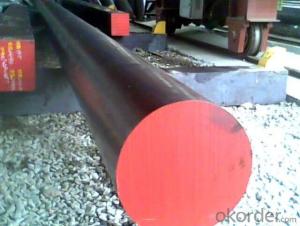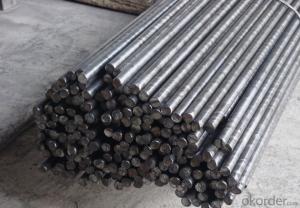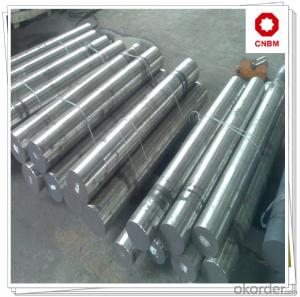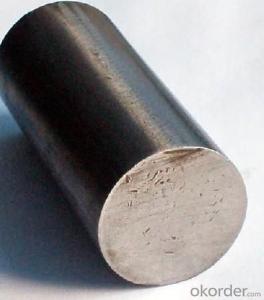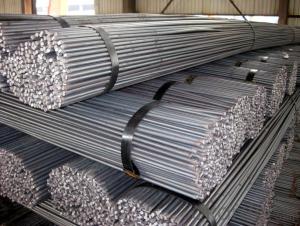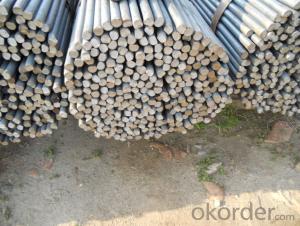Tool Steel with Many Kinds and Sizes
- Loading Port:
- China main port
- Payment Terms:
- TT or LC
- Min Order Qty:
- 25 m.t.
- Supply Capability:
- 10000 m.t./month
OKorder Service Pledge
OKorder Financial Service
You Might Also Like
Product Description:
OKorder is offering Tool Steel at great prices with worldwide shipping. Our supplier is a world-class manufacturer of steel, with our products utilized the world over. OKorder annually supplies products to European, North American and Asian markets. We provide quotations within 24 hours of receiving an inquiry and guarantee competitive prices.
Product Applications:
High Quality Bearing steel is used for manufacturing ball, roller bearing steel and rings. Bearing in work is under great pressure and friction, so have high demands bearing steel and hardness and resistance, and high elastic limit.
Bearing steels are used for ball and roller bearing applications and are comprised of low carbon steels and high carbon through harden able steel.
For example, bearing ring, steel rolling mill, machinery, 100Cr6 bearing steel ball is widely used in high-speed and low-noise bearing, bicycle, motorcycle, automobile, bags electronically.
Product Advantages:
OKorder's Tool Steel are durable, strong, and resist corrosion.
Main Product Features:
· Premium quality
· Prompt delivery & seaworthy packing (30 days after receiving deposit)
· Corrosion resistance
· Can be recycled and reused
· Mill test certification
· Professional Service
· Competitive pricing
Product Specifications:
Grade | bearing steel EN-31 |
Dimensions | Diameter: 20-280mm Length: 2000-5800mm |
Shape | Round Bar |
Type | High chromium bearing steel |
HBS | <220< span=""> |
Standard | AISI |
Technique | Hot Rolled |
Note of High Quality Bearing Steel
1. According to national standard (GB) for our products, if not, supply according to national standards (GB) or agreement.
2. We can not only provide electric furnace +LF+VD and electros lag re-melting (ESR) steel forging materials, but also forging products of piece, bar, etc.
3. Our company is equipped with roll equipment and can provide our customers with roll billets or finished.
4. The materials that we purchase are all accord with International General Standard; you could check it out on the Material Quality Sheet.
5. We are the creator of the “seven-step inspect method” in China.
FAQ:
Q1: Why buy Materials & Equipment from OKorder.com?
A1: All products offered byOKorder.com are carefully selected from China's most reliable manufacturing enterprises. Through its ISO certifications, OKorder.com adheres to the highest standards and a commitment to supply chain safety and customer satisfaction.
Q2: How do we guarantee the quality of our products?
A2: We have established an advanced quality management system which conducts strict quality tests at every step, from raw materials to the final product. At the same time, we provide extensive follow-up service assurances as required.
Q3: How soon can we receive the product after purchase?
A3: Within three days of placing an order, we will begin production. The specific shipping date is dependent upon international and government factors, but is typically 7 to 10 workdays.
Images:
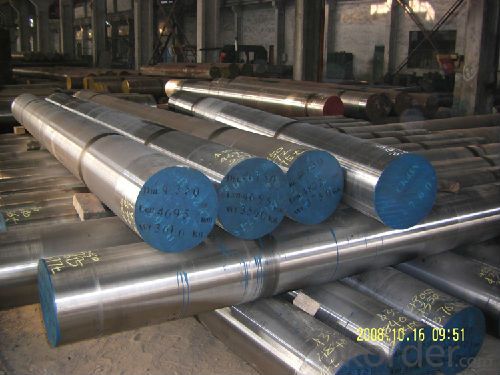
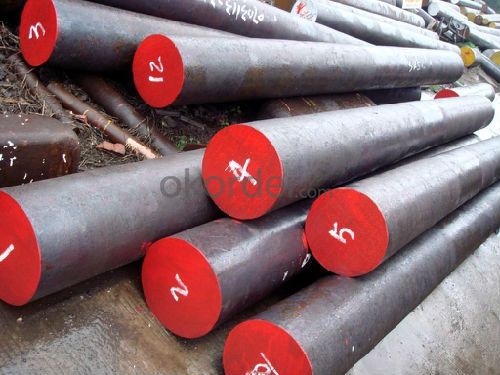
- Q:What are the different international standards for steel round bars?
- Steel round bars have several international standards that define their specifications and requirements. Some commonly used standards are as follows: 1. ASTM A36/A36M: This standard focuses on carbon structural steel shapes, plates, and bars of structural quality. It is used in the construction of bridges and buildings through riveting, bolting, or welding. It specifies the chemical composition, mechanical properties, and dimensional tolerances for steel round bars. 2. ASTM A615/A615M: This standard lays down the requirements for deformed and plain carbon-steel bars used for concrete reinforcement. It covers bars with diameters ranging from 6 to 60 mm and provides guidelines for chemical composition, mechanical properties, and bend tests. 3. BS 4449: This British Standard deals with steel bars used to reinforce concrete. It outlines the requirements for carbon steel bars in different grades, such as B500B and B500C. It specifies the tensile properties, chemical composition, and dimensional tolerances for these steel round bars. 4. DIN 17100: This German standard specifies general structural steels, including steel round bars. It provides guidelines for the chemical composition, mechanical properties, and technical delivery conditions for various grades of steel bars. 5. JIS G3101: This Japanese Industrial Standard covers general structure rolled steel used for various applications. It includes steel round bars and defines the chemical composition, mechanical properties, and dimensional tolerances for different grades of steel bars. 6. ISO 6935-2: This International Organization for Standardization standard specifies the requirements for hot-rolled steel bars used for concrete reinforcement. It provides guidelines for the chemical composition, mechanical properties, and dimensional tolerances of steel round bars used in construction. These examples represent only a few of the international standards available for steel round bars. To ensure compliance and quality of the steel round bars used, it is essential to consult the appropriate standard based on the specific application and requirements.
- Q:Are steel round bars suitable for decorative purposes?
- Indeed, decorative purposes can be served by steel round bars. Steel, being a versatile and durable material, can be molded and crafted into numerous designs and patterns. The application of steel round bars extends to the creation of decorative elements like railings, furniture, sculptures, and architectural details. The polished and lustrous surface of steel contributes a contemporary and elegant touch to any area. Moreover, the strength and longevity associated with steel make it a pragmatic option for decorative endeavors, as it can endure environmental conditions and preserve its visual appeal throughout time.
- Q:What are the different types of tests performed on steel round bars for quality control?
- Steel round bars undergo various tests for quality control purposes to ensure they meet the necessary standards and specifications. These tests include: 1. Tensile Test: This test assesses the tensile strength, yield strength, and elongation properties of the steel bars. It involves applying a pulling force until the bar breaks, measuring the maximum force it can endure, and determining its ability to stretch without fracturing. 2. Hardness Test: The hardness test determines the steel bar's resistance to indentation or scratching, providing insight into its strength and durability. Common hardness tests include Rockwell, Brinell, and Vickers tests. 3. Chemical Composition Analysis: This analysis identifies the steel round bars' chemical composition, including the percentage of elements like carbon, manganese, sulfur, phosphorus, and others. It ensures compliance with specified composition requirements. 4. Ultrasonic Testing: Ultrasonic testing utilizes high-frequency sound waves to detect internal defects or discontinuities within the steel bars. This non-destructive test identifies cracks, voids, or other flaws that may compromise their structural integrity. 5. Dimensional Inspection: This inspection verifies whether the steel round bars meet the required dimensional tolerances, including diameter, length, and straightness. Precision measuring instruments such as calipers, micrometers, and gauges are used to ensure accurate dimensions. 6. Surface Quality Examination: This examination checks the surface condition of the steel bars for defects like cracks, pits, scratches, or irregularities. A smooth and defect-free surface is crucial for proper functionality and safety. 7. Microstructure Analysis: This analysis involves examining the internal structure of the steel bars under a microscope to determine grain size, inclusion content, and overall microstructural integrity. It provides insights into their mechanical properties and ability to withstand various loads and stresses. By conducting these tests, manufacturers guarantee that the steel round bars meet the required quality standards and are suitable for their intended applications.
- Q:What are the different types of steel round bar heat treatments?
- There are several different types of heat treatments for steel round bars, each designed to enhance specific properties of the material. Some of the most common heat treatments include annealing, normalizing, quenching and tempering, and case hardening. 1. Annealing: This heat treatment involves heating the steel round bar to a high temperature and then slowly cooling it to room temperature. Annealing helps to relieve internal stresses, improve machinability, and increase ductility and toughness. 2. Normalizing: Similar to annealing, normalizing also involves heating the steel round bar to a specific temperature. However, instead of slow cooling, the bar is allowed to cool in air. Normalizing helps to refine the grain structure, enhance mechanical properties, and improve machinability. 3. Quenching and Tempering: Quenching is a process in which the steel round bar is heated to a high temperature and then rapidly cooled by immersing it in a quenching medium, such as oil or water. This rapid cooling helps to achieve high hardness and strength in the material. After quenching, the steel is often tempered by reheating it to a lower temperature, which improves toughness and reduces brittleness. 4. Case Hardening: This heat treatment is used to increase the surface hardness of the steel round bar while maintaining a tough core. Case hardening involves heating the bar in the presence of carbon-rich substances, such as gas or liquid carburizing agents. This results in a hardened outer layer, known as the case, while the core remains relatively softer and more ductile. These are just a few examples of the various heat treatments that can be applied to steel round bars. The specific heat treatment used depends on the desired properties and applications of the steel, and it is important to consult with metallurgical experts to ensure the most appropriate treatment is chosen for each specific steel round bar.
- Q:How do steel round bars compare to titanium round bars?
- Steel round bars and titanium round bars have distinct properties and are used for different purposes. Steel round bars are known for their high strength, durability, and affordability. They are commonly used in construction, manufacturing, and general engineering applications. On the other hand, titanium round bars are much lighter, have superior corrosion resistance, and exhibit high strength-to-weight ratio. This makes them suitable for aerospace, medical, and marine industries where weight reduction and resistance to harsh environments are crucial. Ultimately, the choice between steel and titanium round bars depends on the specific requirements and desired characteristics for the intended application.
- Q:What is the difference between a turned and a ground steel round bar?
- Two distinct types of steel bars, a turned steel round bar and a ground steel round bar, have undergone different manufacturing procedures. To create a turned steel round bar, a cylindrical steel rod is rotated against a cutting tool, which eliminates material from the bar's surface to achieve the desired dimensions and finish. This process enhances the bar's dimensional accuracy and smoothness. Turned steel round bars find common usage in precision machining or automotive components that necessitate tight tolerances and a smooth surface finish. Conversely, a ground steel round bar is manufactured by passing a turned steel round bar through a grinding machine. This machine uses an abrasive wheel to eliminate any surface imperfections or irregularities from the bar. The grinding process ensures that the bar maintains a consistent diameter and a smooth, polished surface. Ground steel round bars often find application in aerospace components or hydraulic cylinders that demand a high level of precision and surface finish. In conclusion, the primary distinction between a turned and a ground steel round bar lies in the manufacturing processes they undergo. While turned bars are created by cutting material from the surface, ground bars are refined by grinding to achieve superior dimensional accuracy and surface smoothness. The selection between turned and ground steel round bars is contingent upon the specific requirements of the application and the desired level of precision and surface finish.
- Q:Can steel round bars be used for valve stem applications?
- Steel round bars can indeed be utilized for valve stem applications. Their exceptional strength and durability make them a popular choice in numerous industrial settings. In valve stem applications, steel round bars are frequently employed to offer stability and structural support to the valve stem, thus guaranteeing seamless operation and enduring performance. Moreover, steel round bars can be effortlessly machined and fabricated to meet precise specifications, rendering them an adaptable option for valve stem applications.
- Q:What are the advantages of using nickel-tungsten alloy steel round bars?
- There are several advantages of using nickel-tungsten alloy steel round bars: 1. High strength and durability: Nickel-tungsten alloy steel round bars have excellent strength and durability properties. This makes them suitable for applications that require resistance to wear, fatigue, and high-temperature environments. 2. Corrosion resistance: The addition of nickel in the alloy enhances its corrosion resistance properties. This makes nickel-tungsten alloy steel round bars highly resistant to various corrosive environments, including acids, alkalis, and seawater. 3. Excellent heat resistance: Nickel-tungsten alloy steel round bars exhibit excellent heat resistance, which allows them to maintain their mechanical properties even at elevated temperatures. This makes them ideal for applications that involve high-temperature environments, such as in the aerospace and automotive industries. 4. Good electrical conductivity: The inclusion of tungsten in the alloy enhances its electrical conductivity properties. This makes nickel-tungsten alloy steel round bars suitable for applications that require good electrical conductivity, such as in electrical connectors and electronic devices. 5. Machinability: Nickel-tungsten alloy steel round bars are relatively easy to machine, allowing for the production of complex shapes and designs. This makes them versatile and suitable for various manufacturing processes, including machining, forging, and welding. 6. Cost-effective: Despite their advantageous properties, nickel-tungsten alloy steel round bars are relatively cost-effective compared to other high-performance alloys. This makes them a cost-efficient choice for many industries, as they offer a balance between performance and affordability. Overall, the advantages of using nickel-tungsten alloy steel round bars make them a preferred material for a wide range of applications, including aerospace, automotive, electrical, and manufacturing industries.
- Q:Can steel round bars be used in high-temperature environments?
- Yes, steel round bars can be used in high-temperature environments. However, the specific type of steel and its composition need to be carefully chosen to ensure it has the necessary heat resistance properties, such as high melting point and good strength retention at elevated temperatures.
- Q:How do you identify the grade of a steel round bar?
- The grade of a steel round bar can be identified through several methods. One way is to check the markings or labels on the bar itself. Manufacturers often stamp or engrave the grade directly onto the surface of the bar. These markings typically include information such as the grade designation (e.g., 304, 316, 4140), which represents the specific alloy composition, and may also include additional details such as the heat or lot number. Another method is to refer to the mill test certificate (MTC) that accompanies the steel round bar. The MTC provides comprehensive information about the composition, mechanical properties, and other relevant specifications of the material. The MTC is usually issued by the steel mill or supplier and can be requested upon purchase. Moreover, visual inspection and physical testing can help identify the grade of a steel round bar. Visual inspection involves observing the bar's appearance, texture, and color. Different grades of steel may exhibit distinct characteristics, such as a shiny or matte finish, specific surface treatments, or variations in color due to different alloying elements. Physical testing methods, such as tensile or hardness testing, can provide further confirmation of the steel grade. These tests measure the mechanical properties of the material, such as its strength, ductility, and hardness. By comparing the test results with known standards and specifications for different steel grades, one can determine the grade of the round bar. In summary, to identify the grade of a steel round bar, one can check for markings on the bar, refer to the mill test certificate, visually inspect the bar, and perform physical tests to assess its mechanical properties.
1. Manufacturer Overview |
|
|---|---|
| Location | |
| Year Established | |
| Annual Output Value | |
| Main Markets | |
| Company Certifications | |
2. Manufacturer Certificates |
|
|---|---|
| a) Certification Name | |
| Range | |
| Reference | |
| Validity Period | |
3. Manufacturer Capability |
|
|---|---|
| a)Trade Capacity | |
| Nearest Port | |
| Export Percentage | |
| No.of Employees in Trade Department | |
| Language Spoken: | |
| b)Factory Information | |
| Factory Size: | |
| No. of Production Lines | |
| Contract Manufacturing | |
| Product Price Range | |
Send your message to us
Tool Steel with Many Kinds and Sizes
- Loading Port:
- China main port
- Payment Terms:
- TT or LC
- Min Order Qty:
- 25 m.t.
- Supply Capability:
- 10000 m.t./month
OKorder Service Pledge
OKorder Financial Service
Similar products
New products
Hot products
Hot Searches
Related keywords






